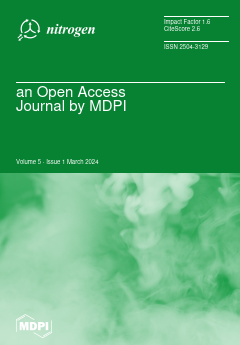Common bean (
Phaseolus vulgaris L.) ranks among the most produced and consumed legume crops and contains essential macro- and micronutrients. Grain yield of the food crop is markedly decreased by poor management, especially a lack of additional essential nutrient elements through the application of fertilizers. In addition to the application of fertilizers, scholarly research and crop farmers have shown that the use of biofertilizer inoculants improves the yield of legume crops. The objective of this research study was to assess the effectiveness of peat-based
Rhizobium tropici sp. UD5 on the growth, yield, and nitrogen concentration of common bean. The peat inoculant contained 6.5 × 10
9 viable cells/g. The experiment was conducted in two climatic zones, as described by the Koppen–Gieger climatic classification system. Treatments involved the peat-based inoculant
Rhizobium tropici (T0 = 0 g without inoculation, T1 = 250 g of peat inoculant of strain UD5 for 50 kg seeds, T2 = 500 g of inoculant of strain UD5, and T3 = 200 g of comparative peat inoculant). The results indicated that common-bean-inoculated formulation of
R. tropici sp. strain UD5 increased the following parameters compared to the controls: plant height (T1 = 18.22%, T2 = 20.41%, and T3 = 19.93% for bioclimatic zone 1; T1 = 16.78%, T2 = 20.71%, and T3 = 19.93% for bioclimatic zone 2), root length (T1 = 13.26%, T2 = 21.28%, and T3 = 19.38% for zone 1; T1 = 15.06%, T2 = 23.70%, and T3 = 19.20% for zone 2), number of nodules (T1 = 1162.57%, T2 = 1166.36%, and T3 = 1180.30% for zone 1; T1 = 1575%, T2 = 1616.5%, and T3 = 1608.25% for zone 2), size of nodules (T1 = 224.07%, T2 = 224.07%, and T3 = 208.33% for zone 1; T1 = 166.4%, T2 = 180%, and T3 = 140% for zone 2), and yield (T1 = 40.49%, T2 = 47.10%, and T3 = 45.45% for zone 1; T1 = 62.16%, T2 = 54.05%, and T3 = 58.55% for zone 2).
R. tropici sp. UD5 peat inoculant formulation also increased the nitrogen concentration in leaves compared to the control (T1 = 3.75%, T2 = 1.12%, and T3 = 8.72%) in both bioclimatic zones. The findings of this study provide significant information on the positive effect of
R. tropic UD5 strain peat inoculant application in the improvement of plant growth, development, and yield through the formation of nodules.
Full article





